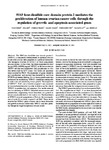WAP four-disulfide core domain protein 2 mediates the proliferation of human ovarian cancer cells through the regulation of growth- and apoptosis-associated genes
| dc.contributor.author | CHEN, YAO | |
| dc.contributor.author | MU, XIA | |
| dc.contributor.author | WANG, S | |
| dc.contributor.author | ZHAO, L | |
| dc.contributor.author | WU, Y | |
| dc.contributor.author | Li, Ji-Liang | |
| dc.contributor.author | LI, M | |
| dc.date.accessioned | 2017-11-27T15:36:50Z | |
| dc.date.available | 2017-11-27T15:36:50Z | |
| dc.date.issued | 2013-01 | |
| dc.identifier.issn | 1021-335X | |
| dc.identifier.issn | 1791-2431 | |
| dc.identifier.uri | http://hdl.handle.net/10026.1/10294 | |
| dc.description.abstract |
The WAP four-disulfide core domain protein 2 (WFDC2) is frequently overexpressed in epithelial ovarian cancer cells and has been proposed as a potential biomarker. The biological function of WFDC2 in tumor progression remains unclear. In this study, the stable expression of short hairpin RNA (shRNA) against WFDC2 in the human ovarian SKOV3 cell line was established. Cell proliferation in vitro was determined by MTT assay. Cell cycle and apoptosis were analyzed by FACS. The expression of genes related to cell proliferation and survival was detected by real-time RT-PCR and western blotting. In vivo tumor growth assay was performed by establishing WFDC2-knockdown xenografts in nude mice and monitoring tumor growth. The expression of WFDC2, Ki67 and activated caspase-3 was analyzed by immunohistochemistry in order to determine the role of WFDC2 in proliferation and apoptosis. Our results revealed that the silencing of WFDC2 abolished ovarian cancer cell proliferation, suppressing tumor formation and growth in ovarian cancer cells both in vitro and in vivo. The knockdown of WFDC2 induced upregulation of Fasl and the downregulation of cyclin D1 activated caspase-3 and Ki67. These results indicate that WFDC2 plays a crucial role in tumor formation and growth in ovarian cancer cells. WFDC2 may be a potential therapeutic target for epithelial ovarian cancer. | |
| dc.format.extent | 288-296 | |
| dc.format.medium | Print-Electronic | |
| dc.language | en | |
| dc.language.iso | eng | |
| dc.publisher | Spandidos Publications | |
| dc.subject | WAP four-disulfide core domain protein 2 | |
| dc.subject | ovarian cancer | |
| dc.subject | cell proliferation | |
| dc.subject | apoptosis | |
| dc.title | WAP four-disulfide core domain protein 2 mediates the proliferation of human ovarian cancer cells through the regulation of growth- and apoptosis-associated genes | |
| dc.type | journal-article | |
| dc.type | Journal Article | |
| dc.type | Research Support, Non-U.S. Gov't | |
| plymouth.author-url | https://www.webofscience.com/api/gateway?GWVersion=2&SrcApp=PARTNER_APP&SrcAuth=LinksAMR&KeyUT=WOS:000312183900040&DestLinkType=FullRecord&DestApp=ALL_WOS&UsrCustomerID=11bb513d99f797142bcfeffcc58ea008 | |
| plymouth.issue | 1 | |
| plymouth.volume | 29 | |
| plymouth.publication-status | Published | |
| plymouth.journal | Oncology Reports | |
| dc.identifier.doi | 10.3892/or.2012.2114 | |
| plymouth.organisational-group | /Plymouth | |
| plymouth.organisational-group | /Plymouth/REF 2021 Researchers by UoA | |
| plymouth.organisational-group | /Plymouth/REF 2021 Researchers by UoA/UoA01 Clinical Medicine | |
| plymouth.organisational-group | /Plymouth/REF 2021 Researchers by UoA/UoA01 Clinical Medicine/UoA01 Clinical Medicine | |
| dc.publisher.place | Greece | |
| dcterms.dateAccepted | 2012-09-28 | |
| dc.identifier.eissn | 1791-2431 | |
| dc.rights.embargoperiod | Not known | |
| rioxxterms.versionofrecord | 10.3892/or.2012.2114 | |
| rioxxterms.licenseref.uri | http://www.rioxx.net/licenses/all-rights-reserved | |
| rioxxterms.licenseref.startdate | 2013-01 | |
| rioxxterms.type | Journal Article/Review |


